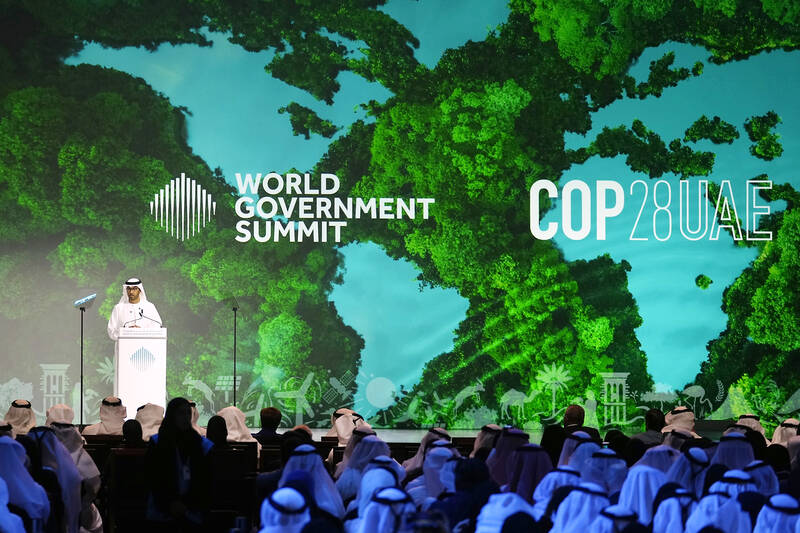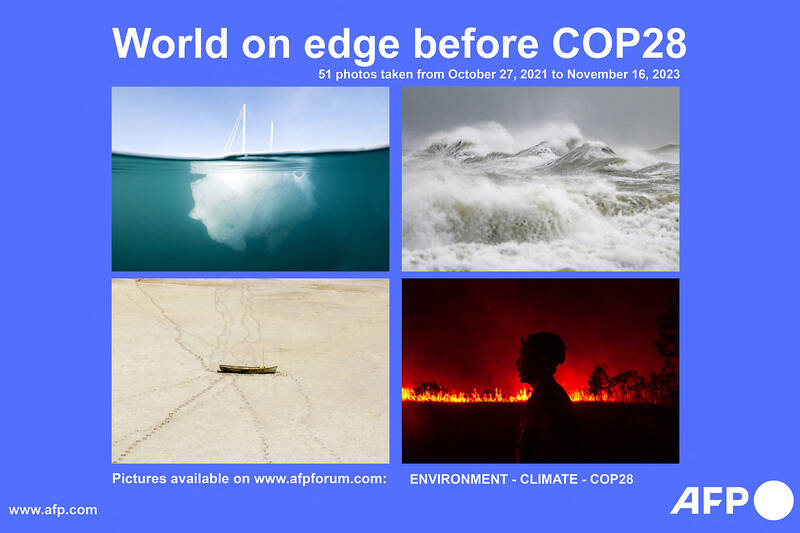Growing calls for the world to come to grips with the many ways that global warming affects human health have prompted the first day dedicated to the issue at crunch UN climate talks starting this week.
Extreme heat, air pollution and the increasing spread of deadly infectious diseases are just some of the reasons the World Health Organization has called climate change the single biggest health threat facing humanity.
Global warming must be limited to the Paris Agreement target of 1.5 degrees Celsius “to avert catastrophic health impacts and prevent millions of climate change-related deaths,” according to the WHO.

Photo: AP 照片:美聯社
However, under current national carbon-cutting plans, the world is on track to warm up to 2.9C this century, the UN said last week.
While no one will be completely safe from the effects of climate change, experts expect that most at risk will be children, women, the elderly, migrants and people in less developed countries, which have emitted the least planet-warming greenhouse gases.
On Dec. 3, the COP28 negotiations in Dubai will host the first “health day” ever held at the climate negotiations.

Photo: AFP 照片:法新社
EXTREME HEAT
This year is widely expected to be the hottest on record. And as the world continues to warm, even more frequent and intense heatwaves are expected to follow.
Heat is believed to have caused more than 70,000 deaths in Europe during summer last year, researchers said last week, revising the previous number up from 62,000.
Worldwide, people were exposed to an average of 86 days of life-threatening temperatures last year, according to the Lancet Countdown report earlier last week.
The number of people over 65 who died from heat rose by 85 percent from 1991-2000 to 2013-2022, it added.
And by 2050, more than five times more people will die from the heat each year under a 2C warming scenario, the Lancet Countdown projected.
More droughts will also drive rising hunger. Under the scenario of 2C warming by the end of the century, 520 million more people will experience moderate or severe food insecurity by 2050.
Meanwhile, other extreme weather events such as storms, floods and fires will continue to threaten the health of people across the world.
AIR POLLUTION
Almost 99 percent of the world’s population breathes air that exceeds the WHO’s guidelines for air pollution.
Outdoor air pollution driven by fossil fuel emissions kills more than four million people every year, according to the WHO.
It increases the risk of respiratory diseases, strokes, heart disease, lung cancer, diabetes and other health problems, posing a threat that has been compared to tobacco.
The damage is caused partly by PM2.5 microparticles, which are mostly from fossil fuels. People breathe these tiny particles into their lungs, where they can then enter the bloodstream.
While spikes in air pollution, such as extremes seen in India’s capital New Delhi earlier this month, trigger respiratory problems and allergies, long-term exposure is believed to be even more harmful.
However it is not all bad news.
The Lancet Countdown report found that deaths from air pollution due to fossil fuels have fallen 16 percent since 2005, mostly due to efforts to reduce the impact of coal burning.
INFECTIOUS DISEASES
The changing climate means that mosquitoes, birds and mammals will roam beyond their previous habitats, raising the threat that they could spread infectious diseases with them.
Mosquito-borne diseases that pose a greater risk of spreading due to climate change include dengue, chikungunya, Zika, West Nile virus and malaria.
The transmission potential for dengue alone will increase by 36 percent with 2C warming, the Lancet Countdown report warned.
Storms and floods create stagnant water that are breeding grounds for mosquitoes and also increase the risk of water-borne diseases such as cholera, typhoid and diarrhoea.
Scientists also fear that mammals straying into new areas could share diseases with each other, potentially creating new viruses that could then jump over to humans.
(AFP)
越來越多人呼籲世人正視全球暖化對人類健康造成的各種影響,這也促使本週開始的聯合國氣候談判,在第一天的議程專門討論此問題。
世界衛生組織將氣候變遷稱為人類面臨的最大健康威脅,極端高溫、空氣污染與致命傳染病的日益蔓延只是部分原因。
世衛組織表示,全球暖化必須限制在《巴黎協定》攝氏1.5度的目標內,「以避免對健康的災難性影響,並防止數百萬人因氣候變化而死亡」。
然而,聯合國上週表示,根據目前各國的碳減排計畫,本世紀全球氣溫預計將升高攝氏2.9度。
雖然沒有人能夠自外於氣候變遷之影響,但專家預測,面臨最大風險的會是兒童、婦女、老人、移民,以及低度開發國家之人民,這些國家所排放的溫室氣體(即導致地球暖化之元兇)是最少的。
在杜拜舉行的2023聯合國氣候變化大會(簡稱COP28),12月3日將舉辦氣候談判有史以來的首次「健康日」。
極端高溫
今年普遍預估會是有紀錄以來最熱的一年。隨著全球持續暖化,預期之後還會有更頻繁、更強烈的熱浪。
研究人員上週表示,去年夏季的高溫據信在歐洲導致超過7萬人死亡,高於原先估計的6萬2千人。
根據上週稍早發布的《刺胳針倒數》報告,去年平均有86天人們是暴露在危及生命的高溫下,全球皆然。
報告補充說,從1991-2000年到2013-2022年,65歲以上死於高溫的人數增加了85%。
《刺胳針倒數》預測,若氣溫上升攝氏2度,到了2050年,每年死於高溫的人數將增加五倍以上。
更多的乾旱也將導致飢荒加劇。若本世紀末氣溫升高攝氏2度,到2050年,將會有5.2億人遭受中度或嚴重的糧食不足。
同時,風暴、洪水及火災等其他極端天氣事件將繼續威脅世界各地人民的健康。
空氣污染
全球有近99%的人口,所呼吸的空氣超出了世衛組織的空氣汙染指南。
據世界衛生組織稱,化石燃料排放所造成的室外空氣污染,每年造成逾四百萬人死亡。
它會增加罹患呼吸道疾病、中風、心臟病、肺癌、糖尿病及其他健康問題之風險,其威脅堪比菸草。
這種損害部分是由PM2.5微粒所造成,這些微粒主要來自化石燃料。這些微小顆粒被人們吸入肺部,然後由此進入血液。
雖然空氣污染激增(例如本月稍早在印度首都新德里出現的極端情況)會引發呼吸道疾病和過敏,但長期接觸污染的空氣被認為危害更大。
然而,也不全都是壞消息。
《刺胳針倒數》報告發現,自2005年以來,死於化石燃料所造成之空氣污染的人數下降了16%,這主要歸功於減少燃煤影響的努力。
傳染病
氣候變遷意味蚊子、鳥類和哺乳動物將由其過去的棲息地擴散出來,增加其散播傳染病的威脅。
因氣候變化而有更大傳播風險的蚊媒疾病包括登革熱、屈公病、茲卡病毒、西尼羅病毒與瘧疾。
《刺胳針倒數》報告警告說,若氣溫升高攝氏2度,僅就登革熱而言,其傳播潛力便會隨之增加36%。
暴風雨及洪水會造成積水,易孳生病媒蚊,也會增加霍亂、傷寒及腹瀉等水傳播疾病的風險。
科學家也擔心,流浪至新地區的哺乳動物可能會互相傳播疾病,產生新的病毒,然後再傳染給人類。
(台北時報林俐凱編譯)

A: When is the Lantern Festival? B: The festival is celebrated on the 15th day of the first month of the lunar calendar, which fell on Feb. 12 this year. A: Oh no! Did I miss the 2025 Taipei Lantern Festival? B: Yes, you did. But you can still go to the 2025 Taiwan Lantern Festival in Taoyuan, which will run until this Sunday. A: Let’s go admire the exuberant lanterns. A: 元宵節到底是哪一天? B: 就是農曆1月15日啊,今年則落在國曆2月12日。 A: 喔不,我是不是錯過了2025台北燈節? B: 是的,但你還可以去桃園的2025台灣燈會,活動將持續至週日。 A: 那我們去欣賞豐富的花燈秀吧! (By Eddy Chang, Taipei Times/台北時報張聖恩)

A: What’s the theme of the 2025 Taiwan Lantern Festival’s main lantern? B: The theme is “Paradise,” and the main lantern is a snake-shaped “infinity” symbol that features a lighting show every half an hour. A: Cool, I heard that there are over 300 lanterns. B: There are even giant lanterns in the shape of Pikachu and some other popular Pokemon characters. A: Let’s go now. A: 2025台灣燈會主燈的主題是什麼? B: 主題是「無限樂園」!主燈的造型則是蛇形的數學「無限號」,主燈每半小時還有一次燈光秀。 A: 酷喔,聽說總共有300多件花燈作品。 B: 甚至還有皮卡丘和其他熱門寶可夢角色的巨型花燈呢。 A: 哇我們現在就出發吧! (By Eddy Chang, Taipei Times/台北時報張聖恩)

本文由生成式AI協作,本刊編輯編修。 Tucked away in southwestern Taiwan, Yunlin County is a treasure trove of cultural heritage, rich history, and natural beauty. From its stunning temples and glove puppetry to historical architecture and picturesque landscapes, Yunlin rewards those who venture off the beaten path. Yunlin is renowned for its flourishing temple culture. Temples in this region are not merely places of worship but also communal centers where people gather for festivals, rituals, and social functions. One of the most notable temples here is the Beigang Chaotian Temple, which was built more than 300 years ago and is dedicated to Matsu, the sea

Nestled within the heart of Taipei, National Taiwan University (NTU) contains a grand and spacious sanctuary where nature and academia come together in perfect accord. Across its expansive 111-hectare campus, NTU reveals a landscape rich with history, lush greenery, and a thoughtfully preserved ecosystem. This tranquil haven invites visitors to take their time wandering among the elegant buildings, to admire the rare plants, and to experience a space that exudes quiet inspiration. Zhoushan Road: A Gentle Prelude to NTU’s Tranquility Beginning at Gongguan MRT Station, the enchanting avenue Zhoushan Road leads visitors into NTU shaded by golden rain trees, cottonwoods, and Javanese